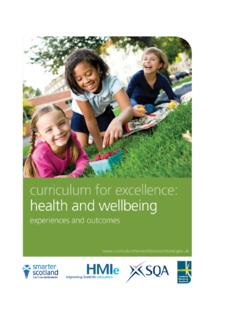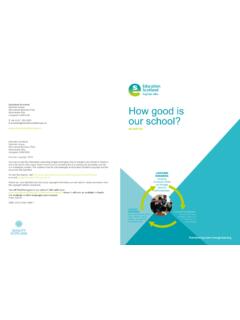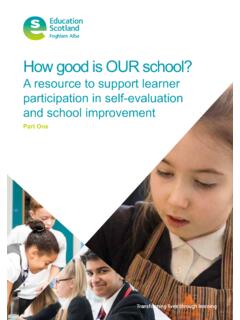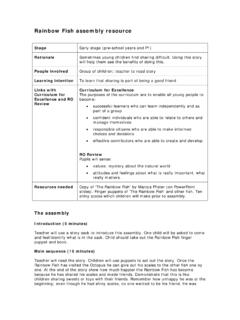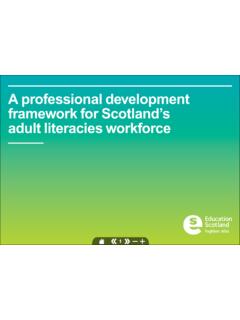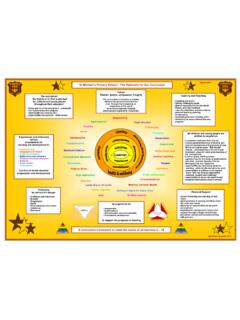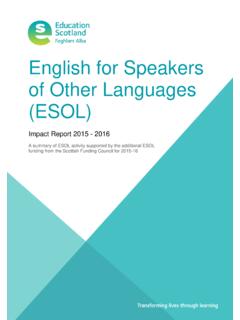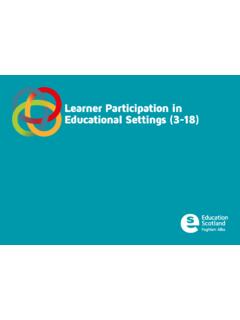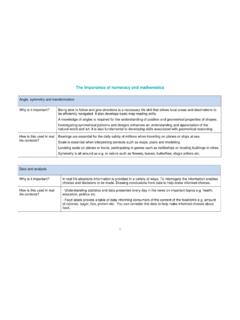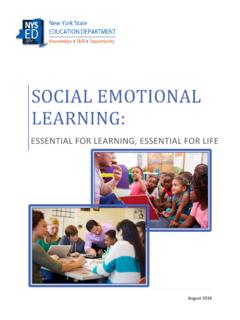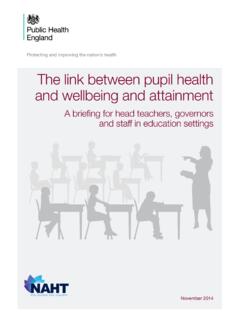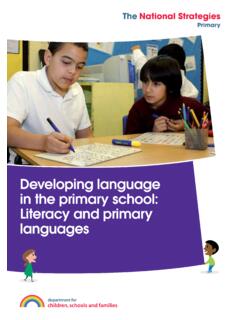Transcription of A Framework to support the Self-evaluation
1 A Framework to support the Self-evaluation of Nurturing Approaches in Schools and Early Learning and Childcare (ELC) SettingsApplying Nurture as a whole school ApproachWe would like to thank the following local authorities who made a key contribution to the development of this Framework :East DunbartonshireGlasgow City CouncilInverclydeNorth AyrshireRenfrewshireSouth AyrshireSouth LanarkshireStirlingWe would also like to thank Kennedy, H; Landor, M and Todd, E (2011) Video Interaction Guidance: A relationship-based intervention to promote attunement, empathy and wellbeing , Jessica Kingsley for their contribution to the material contained in this Rationale 12. A nurturing approach and the Scottish education context 2 3. Aims 104. Development of the Resource 115.
2 A Definition of a nurturing approach 126. The Self-evaluation process 157. The Self-evaluation Quality Indicators 19 Appendix 1 (a): whole school Readiness Checklist 62 Appendix 1 (b): Individual Readiness Checklist 64 Appendix 2: Attunement Profile 66 Appendix 3 (a): Observation Profile the classroom 73 Appendix 3 (b): Observation Profile the playroom 84 Appendix 3 (c): Observation Profile for the school environment 95 Appendix 4 (a): Teacher and Early Years Practitioner Questionnaire 106 Appendix 4 (b): Non-Teaching Staff Questionnaire 115 Appendix 5 (a): Children and Young People Focus Group discussion prompts 126 Appendix 5 (b): Early Years Focus Group discussion prompts 129 Appendix 6.
3 Parent Questionnaire 130At the heart of nurture is a focus on wellbeing and relationships and a drive to support the growth and development of children and young Groups and nurturing approaches are increasingly being introduced across primary, secondary and early learning and child care (ELC) settings. Research clearly demonstrates the impact that Nurture Groups can have on attainment as well as social and emotional competences. Nurture Groups are described as having a positive impact on closing the attainment gap in Closing the Attainment Gap in Scottish Education 1 At the heart of Nurture is a focus on wellbeing and relationships and a drive to support the growth and development of children and young people, many of whom come from areas of disadvantage and require additional targeted support to close the equity gap. Marjorie Boxall first conceived of the idea of Nurture Groups as a way of targeting children and young people who had come from impoverished backgrounds and needed additional support to help them with the recreation of missed early experiences.
4 Nurture Groups in Scotland continue to target support towards children and young people who demonstrate such needs but a wider nurturing approach is also increasingly being promoted in many primary, secondary and early learning and child care settings to support the needs of a wider group of children and young nurturing approach has been promoted as a key approach to supporting behaviour, wellbeing, attainment and achievement in Scottish schools in a number of policy documents including Included, Engaged and Involved, Part 2 2 and Better Relationships, Better Learning and Better Behaviour .3 Local authorities have increasingly promoted a whole school nurturing approach in response to the needs within the school population, particularly with regard to closing the attainment gap, and have developed resources accordingly. Guidance on what a nurturing approach entails, how schools should go about implementing it and how it can be evaluated in order to have the greatest impact on children and young people is a crucial part of taking this forward.
5 Applying Nurture as a whole school approach: A Framework to support the Self-evaluation of nurturing approaches in schools and Early Learning and Childcare settings focuses on these areas, whilst providing additional tools to support the Self-evaluation Rationale1 Sosu, E and Ellis, S Closing the Attainment Gap in Scottish Education . Joseph Rowntree Foundation (2014)2 Included, engaged and involved part 2: a positive approach to managing school exclusions. Scottish Government, 20113 Better Relationships, better learning, better behaviour. Scottish Government, 2013 APPLYING NURTURE AS A whole school APPROACH23 Getting it Right for Every Child (GIRFEC)4 places children and young people s wellbeing at the centre of all assessment and planning. It recognises that children and young people will have different experiences in their lives and has the right to expect appropriate support from adults to allow them to grow and develop and reach their full potential.
6 This is now enshrined in legislation in the Children and Young People (Scotland) Act (2014)5 which reinforces the rights of children and young people. Many of the key components of GIRFEC can be found within a nurturing approach, including the focus on wellbeing, an understanding of resilience and a need to implement thorough assessment to support children and young people s wellbeing needs. The language and structures of GIRFEC and the Children and Young People Act are threaded throughout this Framework . There is also a clear emphasis on a nurturing approach as a universal approach to support children and young people s wellbeing, whilst recognising the need to develop targeted approaches where clear understanding of each of the wellbeing indicators is an important aspect of implementing a nurturing approach fully in a Scottish context, as will the use of the National Practice Model to support assessment.
7 Nurture Principle 3 Nurture is important for the development of self -esteem has also recently been updated by the Nurture Group Network6 to Nurture is important for the development of wellbeing which places a nurturing approach more fully in line with the language of GIRFEC. Nurtured is also one of the wellbeing indicators within GIRFEC as outlined below. It is important to note that nurturing approaches as described in this resource refer to a broader concept of Nurture .2. A nurturing approach and the Scottish education context4 Getting it right for every child, Scottish Government 5 #. Children and Young People (Scotland) Act (2014)6 The Nurture Group Network23 Learning in Health and Wellbeing, is a key part of the Curriculum for Excellence7 and Building the Ambition8 which emphasises the need to ensure that children and young people develop the knowledge and understanding, skills, capabilities and attributes which they need for mental, emotional , social and physical wellbeing now and in the future.
8 Health and Wellbeing is also seen as a Responsibility of All . A focus on a nurturing approach provides schools with a Framework to help them achieve these learnersconfident individualseffective contributorsresponsible citizensgetting it right for every child indicators of wellbeingsafeincludedresponsiblerespecte dactivenurturedachievinghealthyProtected from abuse, neglect or harm at home, at school and in the help to overcome, social, educational, physical and economic inequalities and being accepted as part of the community in which they live and opportunities and encouragement to play active and responsible roles in their schools and communities and where necessary, having appropriate guidance and supervision and being involved in decisions that affect the opportunity, along with carers, to be heard and involved in decisions which affect opportunities to take part in activities such as play.
9 Recreation and sport which contribute to healthy growth and development, both at home and in the a nurturing place to live, in a family setting with additional help if needed or, where this is not possible, in a suitable care supported and guided in their learning and in the development of their skills, confidence and self -esteem at home, at school , and in the the highest attainable standards of physical and mental health, access to suitable healthcare, and support in learning to make healthy and safe startin life:Ready tosucceedThe National Improvement Framework sets out clear priorities to deliver excellence and equity, including: closing the attainment gap between the most and least disadvantaged children and young people and improving children and young people s health and wellbeing. A nurturing approach places both of these priorities at the heart of a school and early learning and child care settings improvement agenda and is a key focus for many Local Authorities to support the closing of the poverty related attainment wheel7 Curriculum for Excellence8 Building the Ambition, National Practice Guidance on Early Learning and Childcare, Children and Young People (Scotland) Act 2014 Scottish GovernmentAPPLYING NURTURE AS A whole school APPROACH45A key focus within Scottish education is to continually drive improvement through Self-evaluation and the wider triangulation of data.
10 The National Improvement Framework also emphasises these aspects and includes a number of key principles. These include the need to:n Recognise that outcomes for children and young people can be improved by improving practice at different levels of the system;n Set out clear responsibilities at national, local and school level and ensure everyone involved has the capacity to play their part effectively;n Use evidence to inform practice and share innovation;n Focus on improving classroom practice and Self-evaluation as key driversThe National Improvement Framework also has a number of key drivers for improvement which feed into the Self-evaluation nurturing approach impacts on all aspects of school /ELC settings and when fully implemented can impact on each of these drivers but in particular: school Improvement, school Leadership, Teacher Professionalism and Parental Engagement.
